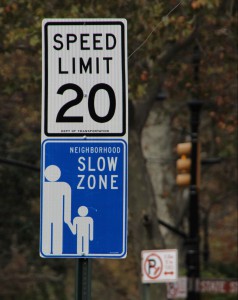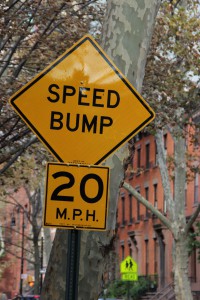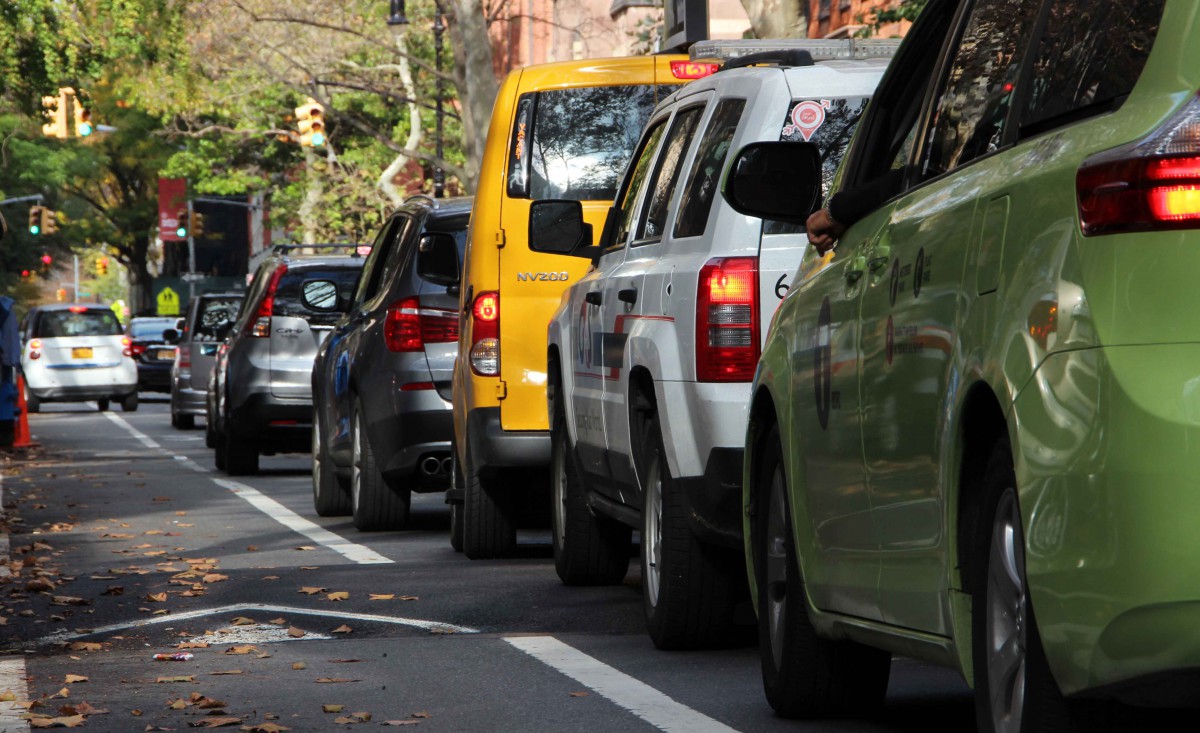There is something new on Clinton Street. It is just paint and plates, but they make a difference.
Motorists entering Brooklyn Heights from Atlantic Avenue face a fresh pedestrian crosswalk and “MPH 20” is written on the street. Aside, two signs: “Slow Zone.”
There is one next to Key Food Market and another in front of Bagel Café.
On its sidewalk, Marta Atwater, an Emmy-winning TV-writer and Brooklyn Heights’ resident, died at 48 on February 22nd, 2013. After she left Bagel Café, Atwater was pinned underneath a 2011 Honda Ridgeline SUV whose 53-year-old driver lost control of his car. He was driving north on Clinton Street and jumped the curb at Atlantic Avenue.
This crash fortified the Brooklyn Heights Association (BHA), a residents’ union, whose board Atwater had joined, to find a solution for Brooklyn Heights’ traffic problems.
 “Streets in the neighborhood serve as shortcuts to the Brooklyn Queens Expressway. Drivers don’t make local stops in the neighborhood but drive very fast to the highway,” said Peter Bray, BHA executive director. So, the BHA affiliated their neighborhood in the slow zone program of New York City’s Department of Transportation (DOT). The speed limit was reduced from 25mp/h to 20mp/h in September and 21 speed hubs were installed.
“Streets in the neighborhood serve as shortcuts to the Brooklyn Queens Expressway. Drivers don’t make local stops in the neighborhood but drive very fast to the highway,” said Peter Bray, BHA executive director. So, the BHA affiliated their neighborhood in the slow zone program of New York City’s Department of Transportation (DOT). The speed limit was reduced from 25mp/h to 20mp/h in September and 21 speed hubs were installed.
New York Police Department data on motor vehicle collisions, available at NYC Open Data, reveal that most crashes in Brooklyn Heights are on streets that run through it like Clinton Street, Henry Street or Hicks Street. So far, there had been eight accidents with at least one person injured this year within the Heights’ historical district borders.
“Too many people don’t realize how residential this area is,” said Emily Liu, a resident and mother of a little boy and another on the way. Pushing her stroller along Henry Street on a sunny October afternoon, motorists smoothly brake when they approach a speed hub.
 Slow zones are part of the City’s “Vision Zero Action Plan”, which aims to reach zero traffic deaths. Speed limits and bumps had been piloted since 2011 in Claremont in the Bronx and were expanded a year later to 16 neighborhoods, among them Boerum Hill in Brooklyn. DOT research has evaluated several slow zones after two years and has found a 10 percent overall reduction in crashes with injuries. “The program is an opportunity for us to increase safety in the neighborhood,” said Bray.
Slow zones are part of the City’s “Vision Zero Action Plan”, which aims to reach zero traffic deaths. Speed limits and bumps had been piloted since 2011 in Claremont in the Bronx and were expanded a year later to 16 neighborhoods, among them Boerum Hill in Brooklyn. DOT research has evaluated several slow zones after two years and has found a 10 percent overall reduction in crashes with injuries. “The program is an opportunity for us to increase safety in the neighborhood,” said Bray.
The BHA’s transport committee conducted a survey among residents. Local churches, schools, senior centers and politicians, including City Councilmember Stephen Levin, a Democrat, wrote letters in support of the BHA’s application. This round, 76 neighborhoods requested to participate. Brooklyn Heights and 13 other neighborhoods were chosen.
And most residents appreciate this prize. “Taxi drivers normally drive as fast as they can. Therefore, the slow zone is a great improvement,” said Paddy Shay, a Heights’ resident. “The speed limit and the hubs improve the situation. The cars slow down, especially near the school right here,” said Lee Hircules, a childcare worker in the Heights, walking with a buggy.
For Quinn Caruthers, a resident and Community Board member, the zone fits into the district. “It is a historical neighborhood,” he said, “and therefore a bit slower.”
But some residents are skeptical. “The speed hubs don’t do anything. They are not very substantial,” said Matt Marks, a resident and driver who nonetheless appreciates that DOT has marked some bike lanes, too. Charmani Timba, a childcare worker, does not think the speed limit improves the situation. “It does not make much of a difference,” she said, “Traffic is a mess.”
When Susan Kuhlmann crosses Cadman Plaza West, she has one or two kids on her hands and is nervous. “Cars passing by our preschool don’t slow down. Some even try to get before us because it takes some time while we cross the street,” Kuhlmann, director of Building Bridges Preschool, said. She wishes there would be more speed hubs around her preschool at Cadman Plaza because the street has frequent traffic to Brooklyn Bridge.
This year, there had been four accidents causing injuries. Cadman Plaza has still a speed limit of 25mp/h, as well as Atlantic Avenue, which is even more dangerous. At the crossing with Hicks Street there had been four crashes so far and additional five incidents at the Clinton Street crossing, where Marta Atwater died. This year, a 66-year-old man was, again, fatally hit by a Mercedes-Benz C300 on August, 9th, but according to principal police investigation the victim was not in the Avenue’s crosswalk.
Nonetheless, a lower speed limit may have saved his life. As a pedestrian, the likelihood to die in a crash at 40mp/h is 70 percent, said Kirstin Miller, Brooklyn Organizer of Transport Alternatives, an organization that lobbies bicycling, walking and public transport in New York. At 20mp/h the likelihood for fatality is just 5 percent. Transport Alternatives welcomes the Heights’ slow zone and has demands for Atlantic Avenue. “We want to reduce the speed limit, have a bike lane and have more pedestrian crossings,” said Miller.
It is just paint and plates but they probably save pedestrians’ and motorists’ lives.
Data Journalism: This map shows accidents with minimum 1 person injured or killed in Brooklyn’s neighborhood with 11201 postal code from 01/01/15 until now (10/19/15). Data based on NYPD motor vehicle collisions according to NYC Open Data. (see also lessons learned). https://en.batchgeo.com/map/6b0ab355095a65ba247b56bef0af4bfc
Update: The batchgeo map is unfortunately only available for 3 month with a free subscription plan.

Kommentare sind geschlossen.